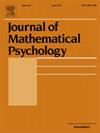The assessment of global optimization skills in procedural knowledge space theory
IF 1.5
4区 心理学
Q2 MATHEMATICS, INTERDISCIPLINARY APPLICATIONS
引用次数: 0
Abstract
Procedural knowledge space theory aims to evaluate problem-solving skills using a formal representation of a problem space. Stefanutti et al. (2021) introduced the concept of the “shortest path space” to characterize optimal problem spaces when a task requires reaching a solution in the minimum number of moves. This paper takes that idea further. It expands the shortest-path space concept to include a wider range of optimization problems, where each move can be weighted by a real number representing its “value”. Depending on the application, the “value” could be a cost, waiting time, route length, etc. This new model, named the optimizing path space, comprises all the globally best solutions. Additionally, it sets the stage for evaluating human problem-solving skills in various areas, like cognitive and neuropsychological tests, experimental studies, and puzzles, where globally optimal solutions are required.
程序知识空间理论中全局优化技能的评估
程序性知识空间理论旨在用问题空间的形式化表示来评估解决问题的能力。Stefanutti等人(2021)引入了“最短路径空间”的概念,当任务需要以最少的移动次数达到解决方案时,该概念描述了最优问题空间。本文进一步阐述了这一观点。它扩展了最短路径空间概念,使其包含更广泛的优化问题,其中每个移动都可以用代表其“值”的实数加权。根据应用程序的不同,“值”可以是成本、等待时间、路由长度等。这个新模型被命名为最优路径空间,它包含了所有全局最优解。此外,它还为评估人类在各个领域解决问题的能力奠定了基础,如认知和神经心理学测试、实验研究和拼图,这些领域需要全局最优解决方案。
本文章由计算机程序翻译,如有差异,请以英文原文为准。
求助全文
约1分钟内获得全文
求助全文
来源期刊

Journal of Mathematical Psychology
医学-数学跨学科应用
CiteScore
3.70
自引率
11.10%
发文量
37
审稿时长
20.2 weeks
期刊介绍:
The Journal of Mathematical Psychology includes articles, monographs and reviews, notes and commentaries, and book reviews in all areas of mathematical psychology. Empirical and theoretical contributions are equally welcome.
Areas of special interest include, but are not limited to, fundamental measurement and psychological process models, such as those based upon neural network or information processing concepts. A partial listing of substantive areas covered include sensation and perception, psychophysics, learning and memory, problem solving, judgment and decision-making, and motivation.
The Journal of Mathematical Psychology is affiliated with the Society for Mathematical Psychology.
Research Areas include:
• Models for sensation and perception, learning, memory and thinking
• Fundamental measurement and scaling
• Decision making
• Neural modeling and networks
• Psychophysics and signal detection
• Neuropsychological theories
• Psycholinguistics
• Motivational dynamics
• Animal behavior
• Psychometric theory
 求助内容:
求助内容: 应助结果提醒方式:
应助结果提醒方式:


